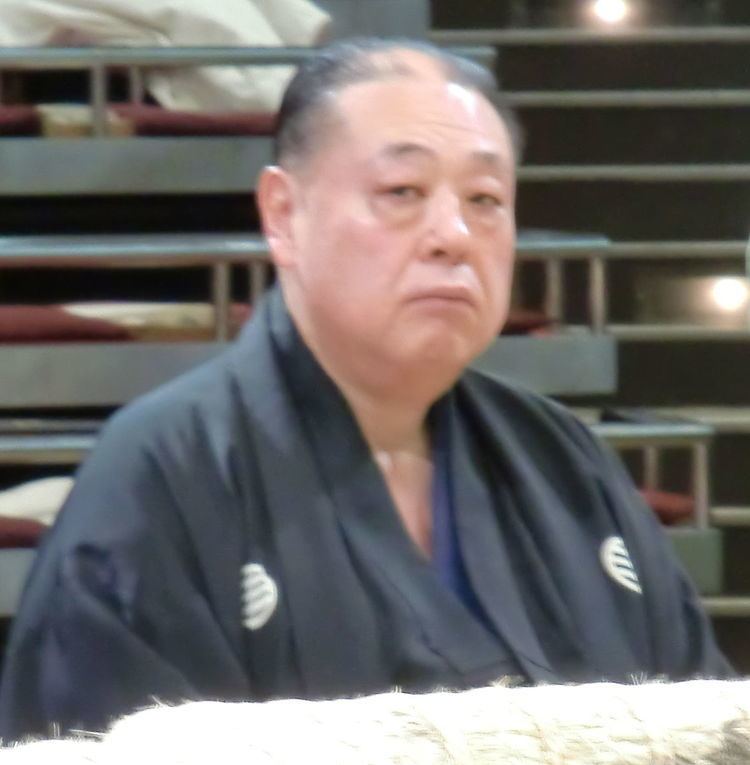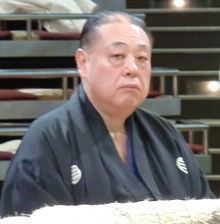Record 964-929-47 Retired January 1988 Name Oshio Kenji Makuuchi rank Komusubi Weight 134 kg | Debut January 1962 Championships 3 (Juryo) Role Sumo Wrestler Height 1.86 m Children Koichi Hatano | |
 | ||
Highest rank Komusubi (January 1978) Special Prizes 1 (Fighting Spirit)1 (Technique) Similar People Kitazakura Hidetoshi, Kaiki Nobuhide, Kirinji Kazuharu, Fujizakura Yoshimori, Asahikuni Masuo | ||
Ōshio Kenji (born 4 January 1948 as Kenji Hatano) is a former sumo wrestler from Kitakyushu, Japan. His highest rank was komusubi. His career lasted twenty six years, from 1962 until 1988, and he holds the record for the most bouts contested in professional sumo.
Contents
Career

He was born in Yahata Higashi ward. He made his professional debut in January 1962 at the age of just 14, joining Tokitsukaze stable. His first stablemaster was the former yokozuna Futabayama. He initially fought under his own surname, Hatano, before adopting the shikona of Ōshio in 1969. He reached the second highest jūryō division in November 1969 and was promoted to the top makuuchi division for the first time in September 1971. He reached his top rank of komusubi in January 1978, but held it for only one tournament. In the May 1978 tournament he defeated Wajima on the opening day, his first ever victory over a yokozuna. He was to earn two more kinboshi in September 1982 and January 1983, at the age of 35. He also earned two special prizes, for Technique and Fighting Spirit.
During his extraordinarily long career Ōshio was ranked in makuuchi for 51 tournaments and 55 tournaments in jūryō, for a total of 106 ranked as an elite sekitori wrestler, a record that stood until 2002 when it was broken by Terao. He holds the "elevator" record for winning promotion to makuuchi from jūryō a total of 13 times. The longest he was able to stay in the top division consecutively was 18 tournaments between January 1981 and November 1983. He fell from makuuchi for the last time in May 1984 and announced his retirement in January 1988 at the age of forty after falling into the non-salaried makushita division. He had competed in 157 tournaments, and had fought a total of 1891 career bouts, which is an all-time record. His total of 964 career wins was also a record at the time, although it was surpassed by Chiyonofuji less than two years later, in September 1989.
Retirement from sumo
Ōshio remained in the sumo world as an elder of the Japan Sumo Association and set up Shikihide stable in May 1992. He did not produce a sekitori until 2012, when his top wrestler Senshō of Mongolia finally won promotion to jūryō in the January tournament after eleven years in sumo. The nineteen years and nine months Shikihide stable took to produce a sekitori is the longest by a newly established stable since World War II. (Senshō also took longer to reach the sekitori ranks than any other foreign recruit since WWII.) He stood down as the head of the stable in December 2012 as he was shortly to reach the mandatory retirement age of 65, and passed over control to the former maegashira Kitazakura. Unusually, Kitazakura belongs to a different ichimon, Dewanoumi, but there was a personal connection as Ōshio was a close friend of Kitazakura′s father.
His son Koichi was born in 1984 and joined Shikihide stable in 1999, fighting under the name of Tamahikari. He reached a highest rank of sandanme 87 before retiring in 2011.
Fighting style
Ōshio's preferred grip on his opponent's mawashi was hidari-yotsu, a right hand outside, left hand inside position. His most commonly used kimarite at sekitori level was yori-kiri, a straightforward force out, which was used in around 30 percent of his victories. He also won frequently with oshi-dashi (push out), yori taoshi (force out and down) and uwatenage (overarm throw).
